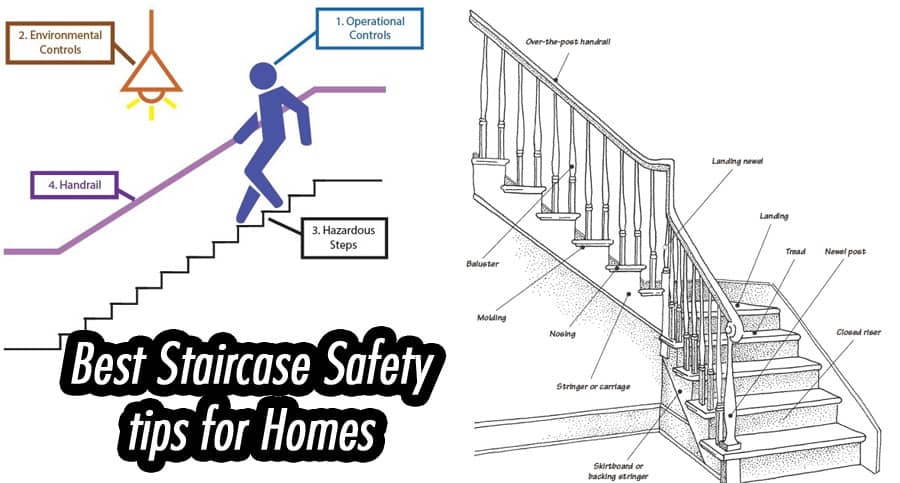Best Staircase Safety tips for Homes

Staircases are vital components of homes, but they also pose potential risks, especially when safety measures are overlooked. Ensuring a secure environment involves a combination of practical strategies and awareness. Here are some essential staircase safety tips that can significantly reduce the risk of accidents at home.
Introduction to Staircase Safety
Staircases are among the most accident-prone areas in homes. Thousands of individuals face injuries due to staircase accidents annually, emphasizing the critical need for safety measures. Understanding the importance of staircase safety is the first step toward preventing such mishaps.
- Importance of Staircase Safety: Accidental falls on stairs result in severe injuries, making it crucial to prioritize safety in this often-overlooked area. Children, elders, and even pets are susceptible to staircase-related accidents, underlining the significance of proactive safety measures.
- Statistics on Staircase Accidents: Statistics reveal alarming rates of injuries caused by staircase accidents, with a significant number being preventable. These incidents can lead to severe consequences, impacting one's quality of life and causing financial burdens.
Choosing the Right Design for Safety
When designing or renovating staircases, focusing on safety features is paramount.
- Optimal Railing Height and Material: The height and material of railings play a crucial role in preventing falls. Adequate railing height and sturdy materials like metal or wood provide necessary support.
- Importance of Handrails and Banisters: Handrails and banisters offer stability and support while ascending or descending stairs. Properly installed and maintained handrails significantly reduce the risk of accidents.
Lighting and Visibility
Good lighting is essential for staircase safety, especially during nighttime or in dimly lit areas.
- Adequate Lighting for Staircases: Ensuring well-lit staircases helps individuals navigate them safely, reducing the chances of trips or falls.
- Use of Motion-Sensor Lights: Motion-sensor lights are an innovative addition, automatically illuminating the stairs when someone approaches, enhancing safety.
Keeping Steps Clear and Maintained
Maintaining a clutter-free staircase is fundamental to preventing accidents.
- Removing Clutter from Stairs: Keeping stairs clear of objects or clutter minimizes tripping hazards, ensuring a safe passage.
- Regular Maintenance Tips for Steps: Regular inspection and maintenance of steps, including fixing loose treads or any structural issues, are crucial for safety.
Non-Slip Surfaces and Traction
Enhancing the traction on stair surfaces reduces the risk of slipping.
- Installing Anti-Slip Treads or Carpets: Applying anti-slip treads or installing carpets on stairs provides better grip, especially in high-traffic areas.
- Using Adhesive Strips or Mats: Adhesive strips or mats placed strategically on steps enhance traction and reduce the likelihood of slipping.
Child Safety Measures
Children are particularly vulnerable to staircase accidents, necessitating specific safety measures.
- Childproofing the Staircase: Installing gates or barriers and teaching children about staircase safety are essential precautions.
- Importance of Supervision: Supervision is key, ensuring that children navigate stairs safely and avoid potential dangers.
Pet Safety Precautions
Pets also require attention when it comes to staircase safety.
- Training Pets around Staircases: Training pets to navigate stairs cautiously minimizes the risk of accidents.
- Installing Gates or Barriers: Installing gates or barriers can restrict pet access to staircases, ensuring their safety.
Educational Awareness
Educating family members about staircase safety fosters a safer environment.
- Teaching Staircase Safety to Family Members: Regular discussions and demonstrations reinforce safe practices among household members.
- Importance of Regular Safety Discussions: Consistent conversations about safety ensure that precautions are not overlooked or forgotten.
Emergency Preparedness
Being prepared for emergencies related to staircase accidents is crucial.
- Keeping Emergency Numbers Accessible: Having emergency contact numbers readily available ensures swift action in case of accidents.
- First Aid Knowledge for Staircase Accidents: Basic first aid training equips individuals to respond promptly to injuries until professional help arrives.
Technology and Safety Innovations
Advancements in technology offer additional safety measures for staircases.
- Smart Sensors for Staircase Safety: Smart sensors can detect movement and alert residents of potential hazards on the stairs.
- Advances in Safety Equipment: Innovative safety equipment like grip-enhancing attachments or specialized handrails enhances staircase safety.
Impact of Age and Mobility
Considerations for individuals with different mobility levels are essential.
- Safety Considerations for Seniors or People with Mobility Challenges: Adapting staircases to accommodate mobility aids or making necessary modifications reduces risks.
- Modifications for Accessibility: Installing ramps or lifts may be necessary for individuals with mobility constraints, ensuring inclusivity.
Professional Safety Assessments
Consulting professionals for safety evaluations is a proactive step.
- Hiring Experts for Safety Evaluations: Safety experts can assess staircases for potential hazards and recommend necessary improvements.
- Consulting with Contractors or Architects: Collaborating with professionals during home renovations ensures adherence to safety standards.
Community Awareness and Support
Spreading awareness beyond one's home contributes to overall safety.
- Promoting Staircase Safety in the Neighborhood: Encouraging neighbors to prioritize staircase safety fosters a safer community environment.
- Sharing Resources and Knowledge: Sharing tips and resources within the community enhances overall safety awareness.
Incorporating Safety into Home Renovations
Integrating safety measures during home upgrades is essential.
- Integrating Safety Measures During Home Upgrades: Incorporating safety features during renovations ensures a safer living environment.
- Importance of Professional Advice: Seeking advice from professionals during renovations ensures optimal safety measures.
Conclusion
Staircase safety is a critical aspect of home life, impacting everyone regardless of age or mobility. Implementing these comprehensive safety tips ensures a secure environment, reducing the risks of accidents and promoting a safer home for all residents.
